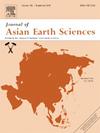Organic matter accumulation and carbon sequestration in the Paleocene-Eocene Thermal Maximum: Insights from the Kongdian Formation in Cangdong Sag, Bohai Bay Basin
IF 2.7
3区 地球科学
Q2 GEOSCIENCES, MULTIDISCIPLINARY
引用次数: 0
Abstract
The Paleocene-Eocene Thermal Maximum (PETM) has attracted much attention due to resembling the modern climatic change. This study focuses on the organic matter accumulation and carbon sequestration under the PETM by the Kongdian Formation in the Cangdong Sag, Bohai Bay Basin using petrography, geochemistry, and X-ray diffraction (XRD). The PETM happened in the second member of the Kongdian Formation (Ek2) which experienced a process of warm-dry to hot-humid to warm-dry variations. Hence the Ek21-2 section has been divided into pre-, core-, and post-PETM. During the pre-PETM, a continuous hot climate strengthened the evaporation to induce the lake salinizing which aggravated water stratification and reducing condition. Intense hydrological cycle resulted in rising terrestrial flux and falling salinity, and more oxidic water column at the core-PETM stage. The salinity continuously falls from the highest point at the post-PETM stage, corresponding to the evaporation weakening and terrestrial input increasing. This caused gradually weakening water stratification and oxidic water column. More saline and reducing conditions promoted the boom of aquatic organism and favorable preservation, so more saturated and aromatic hydrocarbons have been formed at the pre- and post-PETM stages. By contrast, the core-PETM section contains more higher plants with unfavorable preservation, generating less asphaltene. Combined with carbonate and TOC contents, the interplay of organic–inorganic carbon sequestration occurred at the pre- and post-PETM stages, distinct from that at the core-PETM. Injection of light oil from the pre- and post-PETM sections leads to high OSI values of the core-PETM which has good shale oil potentials.
渤海湾盆地沧东凹陷孔店组古新世—始新世热盛期有机质聚集与碳封存
古新世—始新世极热期(PETM)因其与现代气候变化的相似性而备受关注。利用岩石学、地球化学、x射线衍射(XRD)等手段,研究了渤海湾盆地沧东凹陷孔店组PETM下的有机质聚集与固碳作用。新第三纪始新第三纪发生在孔店组二段(Ek2),经历了从暖干到湿热再到暖干的变化过程。因此,将Ek21-2剖面分为前petm、岩心- petm和后petm。在前petm时期,持续炎热的气候加剧了湖泊的蒸发,导致湖泊盐渍化,加剧了水体分层和还原条件。强烈的水文循环导致岩心-始新世期陆地通量上升,盐度下降,氧化水柱增多。盐度从petm后最高点开始持续下降,对应蒸发减弱和陆源输入增加。这导致水体分层和氧化水柱逐渐减弱。较强的盐化和还原条件促进了水生生物的繁盛和有利的保存,因此在petm前和petm后阶段形成了更多的饱和烃和芳烃。相比之下,岩心- petm剖面含有更多保存不利的高等植物,产生较少的沥青质。结合碳酸盐和TOC含量,有机-无机固碳的相互作用发生在第三纪始新世前和后两个阶段,不同于岩心-始新世。petm前后剖面注入轻质油,使得岩心- petm具有较高的OSI值,具有较好的页岩油潜力。
本文章由计算机程序翻译,如有差异,请以英文原文为准。
求助全文
约1分钟内获得全文
求助全文
来源期刊

Journal of Asian Earth Sciences
地学-地球科学综合
CiteScore
5.90
自引率
10.00%
发文量
324
审稿时长
71 days
期刊介绍:
Journal of Asian Earth Sciences has an open access mirror journal Journal of Asian Earth Sciences: X, sharing the same aims and scope, editorial team, submission system and rigorous peer review.
The Journal of Asian Earth Sciences is an international interdisciplinary journal devoted to all aspects of research related to the solid Earth Sciences of Asia. The Journal publishes high quality, peer-reviewed scientific papers on the regional geology, tectonics, geochemistry and geophysics of Asia. It will be devoted primarily to research papers but short communications relating to new developments of broad interest, reviews and book reviews will also be included. Papers must have international appeal and should present work of more than local significance.
The scope includes deep processes of the Asian continent and its adjacent oceans; seismology and earthquakes; orogeny, magmatism, metamorphism and volcanism; growth, deformation and destruction of the Asian crust; crust-mantle interaction; evolution of life (early life, biostratigraphy, biogeography and mass-extinction); fluids, fluxes and reservoirs of mineral and energy resources; surface processes (weathering, erosion, transport and deposition of sediments) and resulting geomorphology; and the response of the Earth to global climate change as viewed within the Asian continent and surrounding oceans.
 求助内容:
求助内容: 应助结果提醒方式:
应助结果提醒方式:


